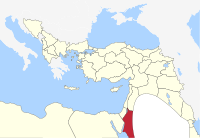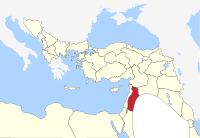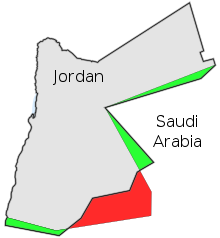| This list is incomplete; you can help by adding missing items. (January 2012) |
This is a timeline of major events in the history of the modern state of Jordan.
Partitioning of the Ottoman Empire period
 Hejaz Vilayet in 1908
Hejaz Vilayet in 1908 Syria Vilayet in 1908The two Ottoman vilayets into which today's Jordan was split
Syria Vilayet in 1908The two Ottoman vilayets into which today's Jordan was split
- 1916: In May, in advance of the Triple Entente's defeat of the Ottoman Empire, the Sykes–Picot Agreement carves it up between Britain and France, defining much of the common border between Syria and what was to become Jordan, Palestine / Israel and Iraq. At the time, the area which is today Jordan was part of the Hejaz vilayet and the Syria vilayet.
- 1916: In June, Hussein bin Ali, Sharif of Mecca entered into an alliance with the United Kingdom and France against the Ottomans sometime around 8 June 1916, the actual date being somewhat uncertain. This alliance began the Arab Revolt.
- 1916: In June, Hussein bin Ali, Sharif of Mecca is declared King of the Kingdom of Hejaz.
- 1917: Auda Abu Tayi and T. E. Lawrence defeat the Ottomans at the Battle of Aqaba – the primary military success of the Hashemite forces in the Arab Revolt.
- 1918: Between April and May, Ottomans repel the First Battle of the Jordan and Second Battle of the Jordan.
- 1918: Between September and October, Triple Entente forces defeat the Ottomans in Megiddo, Damascus, Amman and Deraa.
- 1918: The Ottoman Empire signed the Armistice of Mudros, ending the Middle Eastern theatre of World War I.
- 1918: Faisal, the leader of the Arab revolt and the third son of Hussein bin Ali, King of Hejaz, is declared head of a provisional government in what was previously the Syria vilayet The area which became Trans-Jordan was split between the southern extension of Syria and the northern extension of Hejaz.
- 1920: In March, Faisal proclaimed himself King of the Kingdom of Syria
Mandate for Palestine
- 1920: In April, the San Remo conference formally outlines the proposed French Mandate for Syria and the Lebanon and British Mandate for Palestine along the lines of the Sykes–Picot Agreement. The border between British and French territory would carve northern Trans-Jordan from the Vilayet of Syria, however no direct mention of Trans-Jordan was made at the conference
- 1920: Battle of Maysalun – In July, French forces captured Damascus and expelled Faisal. His brother Abdullah moved his forces into Ma'an (then in the north of the Kingdom of Hejaz) with a view to liberating Damascus, where his brother had been proclaimed King in 1918.
- 1920: In August, Herbert Samuel delivers his speech at Salt, for which he was reprimanded by Curzon
- 1920: In October, Frederick Peake formed a unit of 150 men called the "Mobile Force"
Emirate and Mandate period
Emirate of Trans-Jordan | Mandate for Palestine
- 1921: In March, the Cairo Conference (1921) agrees to award the Emirate of Trans-Jordan to Abdullah and the mandate of Mesopotamia to Faisal During the conference, Winston Churchill convinced Abdullah to stay put and not attack the French because that would threaten his throne in Transjordan since the French had military superiority over his forces.
- 1922: The Council of the League of Nations accepts the British Transjordan memorandum defining the limits of Trans-Jordan and excluding that territory from the provisions in the Mandate concerning the Jewish national home.
Emirate of Trans-Jordan | Trans-Jordan memorandum
- 1922: British Government passes the Order defining Boundaries of Territory to which the Palestine Order-in-Council does not applyl see Trans-Jordan memorandum
- 1923: Britain recognises Transjordan with Abdullah as its leader
- 1923: Frederick Peake's "Mobile Force" becomes Al Jeish al Arabi (the Arab Army), known in English as the Arab Legion
- 1925: Hadda Agreement between TransJordan and Nejd formally agrees the boundary between the two countries following the Kuwait Conference. The agreement concludes by stating "This Agreement will remain in force for so long as His Britannic Majesty's Government are entrusted with the Mandate for Trans-Jordan"
Post-Mandate period
- Hashemite Kingdom of Transjordan
- 1946: Britain ends its mandate over Transjordan, granting full independence to the Kingdom
- 1947: Dead Sea Scrolls discovered
- 1947–48: Thousands of Palestinians flee Arab–Israeli fighting to West Bank and Jordan
- 1948–49: 1948 Arab–Israeli War concludes with the armistice agreements. The territory of the Mandatory Palestine is divided between Israel, Jordan (changed from Transjordan) and Egypt
- Hashemite Kingdom of Jordan
Post 1948 war

- 1951: Riad as-Solh, former Lebanese prime minister, was assassinated in Amman by member of the Syrian Nationalist Party.
- 1951: King Abdullah I of Jordan was assassinated in Jerusalem by a Palestinian after rumors circulating about his intent to sign a peace treaty with Israel. Talal is proclaimed king after his father.
- 1952: Constitution of Jordan established. Talal abdicates the throne due to illness.
- 1955: Wide scale violent anti-Hashemite riots across Jordan result in resignation of the Majali government and retraction of Jordan from the Baghdad Pact. An anti-Christian riot also takes place in Madaba the same year.
- 1956: King Hussein sacks the British personnel in the Jordanian army, an act of Arabization to ensure the complete soveireginty of Jordan.
- 1957: 1957 alleged Jordanian military coup attempt.
- 1958: Arab Federation of Iraq and Jordan created in February, shortly before the creation of United Arab Republic between Egypt and Syria. It was disestablished following the 14 July Revolution in Iraq.
- 1965: Jordan and Saudi Arabia concluded a bilateral agreement that realigned and delimited the boundary, resulting in some exchange of territory, allowing Jordan to expand its port facilities at Aqaba and protecting the pasturage and watering rights of certain nomadic tribes.
- 1967: Six-Day War
Post 1967 war
- 1968: Battle of Karameh between the Israel Defense Forces (IDF) and combined forces of the Palestine Liberation Organization (PLO) and the Jordanian Army.
- 1970: Black September. The PLO were driven out to Lebanon.
- 1973: Yom Kippur War
- 1994: Israel–Jordan Treaty of Peace
- 1999: King Abdullah bin Al Hussein became the 4th king of The Hashemite Kingdom of Jordan.
- 2005: 2005 Amman bombings by Al-Qaeda leader Abu Musab Al-Zarqawi.
- 2010: 2011–12 Jordanian protests breaks out as part of the Arab Spring demanding economic and political reforms.
- 2014: Jordanian intervention in the Syrian Civil War began on 22 September 2014, with air strikes on Islamic State of Iraq and the Levant (ISIL) targets, and escalated after the murder on Muath al-Kasasbeh, a captured Jordanian pilot, by ISIL, in early 2015.
See also
References
- Harding, G. Lankester. 1959. The Antiquities of Jordan. Lutterworth Press, London. 2nd impression, 1960.
- A Peace To End All Peace, David Fromkin, Avon Books, New York, 1990
- ^ Robins, P. (2004). A History of Jordan. Cambridge University Press. p. 21. ISBN 978-0-521-59895-8. Retrieved 2015-04-30.
- Maunsell 1926 p. 212
- Tucker, S.C.; Roberts, P. (2008). Encyclopedia of the Arab-Israeli Conflict, The: A Political, Social, and Military History: A Political, Social, and Military History. ABC-CLIO. p. 354. ISBN 978-1-85109-842-2. Retrieved 2015-04-30.
- Salibi, K.S. (1998). The Modern History of Jordan. I. B. Tauris. p. 42. ISBN 978-1-86064-331-6. Retrieved 2015-04-30.
- "Cairo Conference - 1921 - and T.E. Lawrence". cliohistory.org. Retrieved 2015-04-30.
- "Churchill and Palestine, David Lyon Hurwitz". findarticles.com. Retrieved 2015-04-30.
- Cmd. 5479, 1937, p. 37.
- Leatherdale, C. (1983). Britain and Saudi Arabia, 1925-1939: The Imperial Oasis. F. Cass. p. 378. ISBN 9780714632209. Retrieved 2015-04-30.
- Kamil Dib, "Warlords and Merchants, The Lebanese Business and Political Establishment", page 89
External links
| Years in Jordan (1946–present) | |
|---|---|